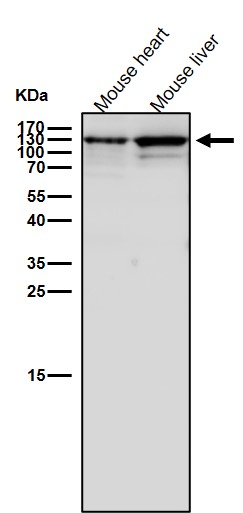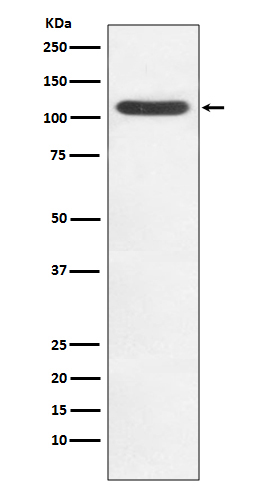

| WB | 咨询技术 | Human,Mouse,Rat |
| IF | 1/20-1/50 | Human,Mouse,Rat |
| IHC | 咨询技术 | Human,Mouse,Rat |
| ICC | 1/50-1/200 | Human,Mouse,Rat |
| FCM | 咨询技术 | Human,Mouse,Rat |
| Elisa | 咨询技术 | Human,Mouse,Rat |
| Aliases | HIP 1; hip1; HIP1/PDGFRB fusion gene; HIPI ; Huntingtin interacting protein 1;;HIP 1 |
| WB Predicted band size | 116 kDa |
| Host/Isotype | Rabbit IgG |
| Antibody Type | Primary antibody |
| Storage | Store at 4°C short term. Aliquot and store at -20°C long term. Avoid freeze/thaw cycles. |
| Species Reactivity | Human,Mouse,Rat |
| Immunogen | A synthesized peptide derived from human HIP 1 |
| Formulation | Purified antibody in PBS with 0.05% sodium azide,0.05% BSA and 50% glycerol. |
+ +
以下是关于HIP1抗体的3篇参考文献及其摘要概括:
---
1. **文献名称**:*Cloning and Characterization of HIP1. a Novel Huntingtin-interacting Protein*
**作者**:Hyun, T.S., et al. (1999)
**摘要**:该研究首次克隆并鉴定了HIP1蛋白,发现其与亨廷顿蛋白(Huntingtin)的相互作用。通过生成的HIP1多克隆抗体,证实其在亨廷顿病患者脑组织中表达异常,提示HIP1可能参与亨廷顿病的病理机制。
---
2. **文献名称**:*HIP1 Expression in Glioblastoma Promotes Tumor Cell Proliferation and Survival*
**作者**:Mao, X., et al. (2003)
**摘要**:研究利用HIP1特异性抗体检测胶质母细胞瘤样本,发现HIP1在肿瘤中显著过表达,并通过激活EGFR信号通路促进癌细胞增殖及存活,表明HIP1可能作为癌症治疗的潜在靶点。
---
3. **文献名称**:*Aberrant HIP1 Trafficking Links Huntington's Disease to Neuronal Dysfunction*
**作者**:Metzler, M., et al. (2003)
**摘要**:通过免疫荧光和Western blot分析(使用HIP1抗体),研究发现突变亨廷顿蛋白导致HIP1在神经元中的异常定位,进而干扰囊泡运输功能,揭示了亨廷顿病中神经退行性变的分子机制。
---
4. *(可选)* **文献名称**:*Phosphorylation-dependent Regulation of HIP1 Actin-binding Function*
**作者**:Bradley, S.V., et al. (2020)
**摘要**:该研究利用HIP1抗体探究其磷酸化修饰对肌动蛋白结合能力的影响,发现特定激酶介导的磷酸化可调控HIP1在细胞迁移中的作用,为靶向HIP1的癌症治疗提供新思路。
---
以上文献涵盖了HIP1抗体的应用场景(如蛋白互作研究、疾病机制探索及功能调控分析),可满足基础实验或疾病研究需求。
HIP1 (Huntingtin-interacting protein 1) is a cytoskeletal protein that interacts with huntingtin, the protein mutated in Huntington’s disease (HD). Initially identified through its binding to the polyglutamine-expanded huntingtin, HIP1 regulates clathrin-mediated endocytosis and receptor trafficking by linking the actin cytoskeleton to membrane-associated proteins. It contains an N-terminal ANTH domain for membrane binding and a C-terminal Talin-like actin-binding domain. Dysregulation of HIP1 is implicated in neurodegenerative disorders and cancer. In HD, altered HIP1-huntingtin interactions may contribute to neuronal dysfunction. HIP1 overexpression has also been observed in cancers, promoting cell proliferation and survival.
HIP1 antibodies are essential tools for studying its expression, localization, and function. They are widely used in techniques like Western blotting, immunofluorescence, and immunohistochemistry to detect HIP1 in cell lines, brain tissues, or tumor samples. Specific HIP1 antibodies help explore its role in disease mechanisms, such as synaptic vesicle recycling defects in HD or oncogenic signaling in malignancies. Validating these antibodies with knockout controls ensures specificity, as HIP1 shares homology with HIP1-related protein (HIP1R). Research utilizing HIP1 antibodies continues to clarify its dual roles in neurodegeneration and cancer progression, offering potential therapeutic insights.
×